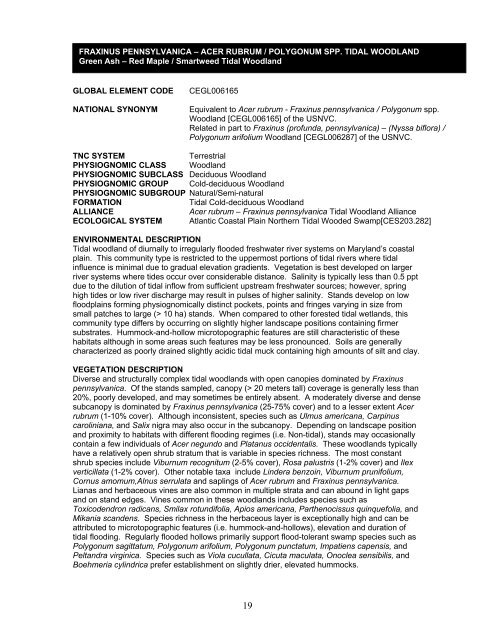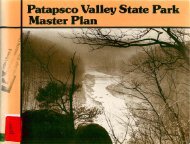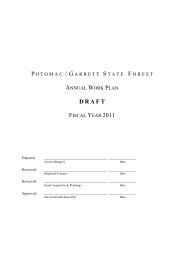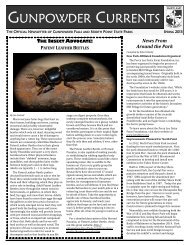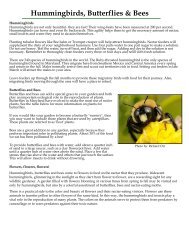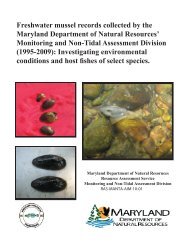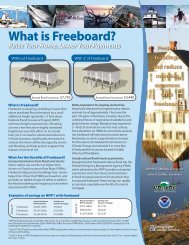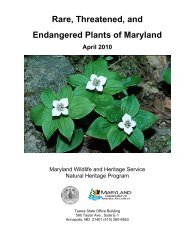tidal hardwood swamps - Maryland Department of Natural Resources
tidal hardwood swamps - Maryland Department of Natural Resources
tidal hardwood swamps - Maryland Department of Natural Resources
You also want an ePaper? Increase the reach of your titles
YUMPU automatically turns print PDFs into web optimized ePapers that Google loves.
FRAXINUS PENNSYLVANICA – ACER RUBRUM / POLYGONUM SPP. TIDAL WOODLAND<br />
Green Ash – Red Maple / Smartweed Tidal Woodland<br />
GLOBAL ELEMENT CODE CEGL006165<br />
NATIONAL SYNONYM Equivalent to Acer rubrum - Fraxinus pennsylvanica / Polygonum spp.<br />
Woodland [CEGL006165] <strong>of</strong> the USNVC.<br />
Related in part to Fraxinus (pr<strong>of</strong>unda, pennsylvanica) – (Nyssa biflora) /<br />
Polygonum arifolium Woodland [CEGL006287] <strong>of</strong> the USNVC.<br />
TNC SYSTEM Terrestrial<br />
PHYSIOGNOMIC CLASS Woodland<br />
PHYSIOGNOMIC SUBCLASS Deciduous Woodland<br />
PHYSIOGNOMIC GROUP Cold-deciduous Woodland<br />
PHYSIOGNOMIC SUBGROUP <strong>Natural</strong>/Semi-natural<br />
FORMATION Tidal Cold-deciduous Woodland<br />
ALLIANCE Acer rubrum – Fraxinus pennsylvanica Tidal Woodland Alliance<br />
ECOLOGICAL SYSTEM Atlantic Coastal Plain Northern Tidal Wooded Swamp[CES203.282]<br />
ENVIRONMENTAL DESCRIPTION<br />
Tidal woodland <strong>of</strong> diurnally to irregularly flooded freshwater river systems on <strong>Maryland</strong>’s coastal<br />
plain. This community type is restricted to the uppermost portions <strong>of</strong> <strong>tidal</strong> rivers where <strong>tidal</strong><br />
influence is minimal due to gradual elevation gradients. Vegetation is best developed on larger<br />
river systems where tides occur over considerable distance. Salinity is typically less than 0.5 ppt<br />
due to the dilution <strong>of</strong> <strong>tidal</strong> inflow from sufficient upstream freshwater sources; however, spring<br />
high tides or low river discharge may result in pulses <strong>of</strong> higher salinity. Stands develop on low<br />
floodplains forming physiognomically distinct pockets, points and fringes varying in size from<br />
small patches to large (> 10 ha) stands. When compared to other forested <strong>tidal</strong> wetlands, this<br />
community type differs by occurring on slightly higher landscape positions containing firmer<br />
substrates. Hummock-and-hollow microtopographic features are still characteristic <strong>of</strong> these<br />
habitats although in some areas such features may be less pronounced. Soils are generally<br />
characterized as poorly drained slightly acidic <strong>tidal</strong> muck containing high amounts <strong>of</strong> silt and clay.<br />
VEGETATION DESCRIPTION<br />
Diverse and structurally complex <strong>tidal</strong> woodlands with open canopies dominated by Fraxinus<br />
pennsylvanica. Of the stands sampled, canopy (> 20 meters tall) coverage is generally less than<br />
20%, poorly developed, and may sometimes be entirely absent. A moderately diverse and dense<br />
subcanopy is dominated by Fraxinus pennsylvanica (25-75% cover) and to a lesser extent Acer<br />
rubrum (1-10% cover). Although inconsistent, species such as Ulmus americana, Carpinus<br />
caroliniana, and Salix nigra may also occur in the subcanopy. Depending on landscape position<br />
and proximity to habitats with different flooding regimes (i.e. Non-<strong>tidal</strong>), stands may occasionally<br />
contain a few individuals <strong>of</strong> Acer negundo and Platanus occidentalis. These woodlands typically<br />
have a relatively open shrub stratum that is variable in species richness. The most constant<br />
shrub species include Viburnum recognitum (2-5% cover), Rosa palustris (1-2% cover) and Ilex<br />
verticillata (1-2% cover). Other notable taxa include Lindera benzoin, Viburnum prunifolium,<br />
Cornus amomum,Alnus serrulata and saplings <strong>of</strong> Acer rubrum and Fraxinus pennsylvanica.<br />
Lianas and herbaceous vines are also common in multiple strata and can abound in light gaps<br />
and on stand edges. Vines common in these woodlands includes species such as<br />
Toxicodendron radicans, Smilax rotundifolia, Apios americana, Parthenocissus quinquefolia, and<br />
Mikania scandens. Species richness in the herbaceous layer is exceptionally high and can be<br />
attributed to microtopographic features (i.e. hummock-and-hollows), elevation and duration <strong>of</strong><br />
<strong>tidal</strong> flooding. Regularly flooded hollows primarily support flood-tolerant swamp species such as<br />
Polygonum sagittatum, Polygonum arifolium, Polygonum punctatum, Impatiens capensis, and<br />
Peltandra virginica. Species such as Viola cucullata, Cicuta maculata, Onoclea sensibilis, and<br />
Boehmeria cylindrica prefer establishment on slightly drier, elevated hummocks.<br />
19


